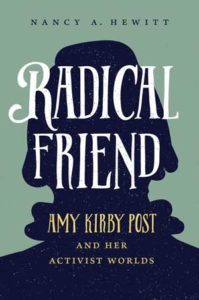Radical Friend: Amy Kirby Post and Her Activist Worlds
Reviewed by Cameron McWhirter
October 1, 2018
 By Nancy A. Hewitt. The University of North Carolina Press, 2018. 440 pages. $39.95/hardcover; $29.99/eBook.
By Nancy A. Hewitt. The University of North Carolina Press, 2018. 440 pages. $39.95/hardcover; $29.99/eBook.
Throughout American history, the Quaker religion has been a breeding ground for radical activists. The nonhierarchical faith has emphasized equality of the sexes and allowed no written doctrine to constrain members’ intellectual and spiritual explorations. Many stayed close to Quaker traditions, while others used them as springboards to new ways of thinking and being.
So it was with Amy Kirby Post (1802–1889) and her husband, Isaac (1798–1872), leading radical activists in Rochester, N.Y. In the 1800s, the city was a booming frontier town in the heart of what became known as the burned-over district of western and central New York State. The region became a center of religious experimentation and social activism, including fighting for equal rights for black people and women.
Nancy Hewitt, professor emerita of history and women’s studies at Rutgers University, has written about women activists in several books, including a history of nineteenth-century Rochester, so she is intimately familiar with the characters and context of the period. As she acknowledges in the book, she has been fascinated by the Posts, particularly Amy, since the late 1970s. Her devotion to the Posts’ story, fleshed out with extensive archival research, has produced a compelling and complete history of the interesting couple and their turbulent times.
The couple were, at first, followers of Elias Hicks (Amy came from Jericho Meeting, which Hicks helped found), and embraced his emphasis on the Inner Light. Later they became vocal and committed followers of spiritualism, a movement based on the belief that through mediums, one can talk with the dead.
The Posts married in 1828, the same year Hicksites split from other Quakers. Many considered the marriage scandalous because Amy married Isaac after his first wife, Amy’s sister, died. The couple lived on a farm in upstate New York until 1836, when they moved to Rochester where Isaac eventually became a successful pharmacist.
Professor Hewitt’s great strength rests in her ability to place the Posts in context, by explaining the importance of religious movements, political events, and activists that thrived in Rochester. The book provides an excellent grounding in American Quakerism, spiritualism, abolitionism, the women’s rights movement, and how they all interacted, united, and divided.
Mrs. Post played a key role in promoting the careers of African American activists, including abolitionist Frederick Douglass, with whom she had deep arguments but ultimately reconciled, and Harriet Jacobs, whom she helped publish Incidents in the Life of a Slave Girl, Jacobs’s autobiography. She also was close with abolitionist and women’s rights activist Sojourner Truth. The Posts’ home was a busy stop on the Underground Railroad.
Hewitt focuses mostly on Mrs. Post’s activism, which was more involved since her husband spent a great deal of time at his pharmacy and on spiritualist matters. He even published a book of messages he allegedly received from beyond the grave.
Mrs. Post was involved in abolition, temperance, women’s rights, prison reform, and education. She also played a crucial role in the women’s rights movement, attending the famous Seneca Falls Convention and working with Lucretia Mott, Susan B. Anthony, and others to advance women’s right to vote for decades. Beyond her broader campaigning, Mrs. Post also quietly aided women in the Rochester area who fled abusive husbands.
Hewitt writes that by 1848, the year of Seneca Falls, “she viewed demands for racial and gender equality and religious liberty in the United States as part of a global democratic surge with international critics of American slavery, European revolutionaries, and newly emancipated Caribbean blacks voicing their own demands.”
I would have appreciated if Radical Friend contained a sharper critique of spiritualism, which gets gentle treatment from Hewitt, though leading mediums were later revealed, or revealed themselves, to be frauds.
As Radical Friend shows, the Posts were so radical that eventually they weren’t Friends, but instead sort of Quakerish spiritualists. The book is, in part, an act of historical recovery—since after Amy and Isaac died, their social activism was largely forgotten. This work goes a long way to restore their place among radicals who worked so hard and long for a range of causes which they considered to be all part of the great cause of human freedom.
1 thought on “Radical Friend: Amy Kirby Post and Her Activist Worlds”
Leave a Reply
Comments on Friendsjournal.org may be used in the Forum of the print magazine and may be edited for length and clarity.



On the one hand, I’m glad to see another woman with Quaker ties lifted up, along with her ministry and witness. On the other hand, I’m so over statements like “the Quaker religion has been a breeding ground for radical activists.”
Such a statement completely erases the full Truth that more and more of us are understanding these days: that our early Quaker predecessors in the USA were very much like other white “Christians” of the time. We enslaved people of African descent far more than we worked for abolition, but that history and “context” is seldom portrayed in our publications.
Friends like John Woolman, Lucretia Mott, and Susan B Anthony were exceptions that we Friends talk about as if every meeting today had at least 2 or 3 or 10 such Friends. It’s simply not true. Before we were abolitionists and suffragists, we were enslavers and supporters of the status quo.
I’m not sure if I’ll be ordering this book any time soon. But I might go back and re-read parts of Fit for Freedom Not for Friendship, as well as the recent Benjamin Lay book. The Truth contained in those books is refreshing and humbling.